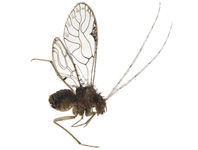Abstract
A new species of symbiotic palaemonid shrimp of the genus Pseudocoutierea Holthuis, 1951, is described based on a specimen collected in the eastern Gulf of Mexico, off the southwest coast of Florida. Pseudocoutierea stephanieae sp. nov., is the seventh known in this genus, and morphologically most similar to P. antillensis Chace, 1972, and P. conchae Criales, 1981, from the western Atlantic, and P. elegans Holthuis, 1952, from the eastern Pacific, all sharing an expanded rostral base or eaves that terminate supra-distally in an acute tooth. This new species can be separated by: the presence of an epigastric knob or tubercle on the anterior mid-dorsal third of the carapace, which is absent in all other congeneric species; the shape of the pterygostomial sinus, which is shallow in this new species, whereas it is deep and well defined in all other congeneric species. An updated dichotomous key to species of Pseudocoutierea is presented.
References
Banner, A.H. (1959) Contributions to the knowledge of the alpheid shrimp of the Pacific Ocean. Part IV. Various small collections from the Central Pacific area, including supplementary notes on alpheids from Hawaii. Pacific Science, 13, 130–155.
Borradaile, L.A. (1900) On the Stomatopoda and Macrura brought by Dr. Willey from the South Seas. In: Willey, A. (Ed.), Zoological results based on material from New Britain, New Guinea, Loyalty Islands and elsewhere, collected during the years 1895, 1896, and 1897, by Arthur Willey, D.Sc. Lond., Hon. M.A. Cantab., plates 36–39, University Press, Cambridge. pp. 395–428.
Brecko, J., Mathys, A., Dekoninck, W., Leponce, M, VandenSpiegel & Semal, D.P. (2014) Focus stacking: Comparing commercial top-end set-ups with a semi-automatic low budget approach. A possible solution for mass digitization of type specimens. ZooKeys, 464, 1–23.
http://dx.doi.org/10.3897/zookeys.464.8615Bruce, A.J. (1966) Notes on Some Indo-Pacific Pontoniinae. II. Platycaris latirostris Holthuis. Crustaceana, 11 (1), 1–9.
http://dx.doi.org/10.1163/156854066X00397Bruce, A.J. (2004) Balsia antipodarum sp. nov., the first occurrence of the genus Balsia Kemp in the Indo-West Pacific region (Crustacea: Decapoda: Pontoniinae). Cahiers de Biologie Marine, 45, 365–372.
Calman, W.T. (1939) Crustacea: Caridea. The John Murray Expedition 1933–1934, Scientific Reports, 6, 183–224.
Chace, F.A. Jr. (1972) The shrimps of the Smithsonian-Bredin Caribbean expeditions with a summary of the West Indian shallow-water species (Crustacea: Decapoda: Natantia). Smithsonian Contributions to Zoology, 98, 1–179.
http://dx.doi.org/10.1163/156854066X00397Coleman, C.O. (2003) "Digital inking": How to make perfect line drawings on computers. Organism, Diversity and Evolution, Electronic Supplement, 14, 1–14. Avaliable from: http://senckenberg.de/odes/03-14.htm (Accessed 6 Oct. 2016)
Coleman, C.O. (2006) Substituting time-consuming pencil drawings in arthropod taxonomy using stacks of digital photographs. Zootaxa, 1360, 61–68.
Coutière, H. (1905) Les Alpheidae. In: Gardiner, J.S. (Ed.), The Fauna and Geography of the Maldive and Laccadive Archipelagoes. Being the account of the work carried on and of the Collections made by an Expedition during the years 1899 and 1900. University Press, Cambridge. pp. 852–921, pls Plates 70–87.
Criales, M.M. (1981) Two new species of Pseudocoutierea (Decapoda Natantia, Palaemonidae) from the Colombian Caribbean. Crustaceana, 41, 167–181.
http://dx.doi.org/10.1163/156854081X00219De Grave, S. (2007) A new species of Pseudocoutierea Holthuis from the Caribbean coast of Panama (Crustacea, Decapoda, Palaemonidae), with a key to the genus. Zootaxa, 1397, 29–37.
De Grave, S., Fransen, H.J.M. & Page, T.J. (2015) Let’s be pals again: major systematic changes in Palaemonidae (Crustacea: Decapoda). PeerJ, e1167.
http://dx.doi.org/10.7717/peerj.1167d’Udekem d’Acoz, C. (2001) Description of Pseudocoutierea wirtzi sp. nov., a new cnidarian associated pontoniine shrimp from Cape Verde Islands, with decalcified meral swellings in walking legs (Crustacea, Decapoda, Caridea). Bulletin de l’Institut Royal des Sciences Naturelles de Belgique, 70, 69–90 [volume for 2000]
Holthuis, L.B. (1951) A general revision of the Palaemonidae (Crustacea Decapoda Natantia) of the Americas, I: The subfamilies Euryrhynchinae and Pontoniinae. Allan Hancock Foundation Occasional Paper, 1–332.
Holthuis, L.B. (1952) The Decapoda of the Siboga Expedition. Part XI. The Palaemonidae collected by the Siboga and Snellius Expeditions with remarks on other species II. Subfamily Pontoniinae. Siboga Expeditie, 39a10, 1–253.
Kemp, S. (1922) Notes on Crustacea Decapoda in the Indian Museum. XV. Pontoniinae. Records of the Indian Museum, 24, 113–288.
Kingsley, J.S. (1879) List of the North American Crustacea belonging to the suborder Caridea. Bulletin of the Essex Institute, 10 [for 1878], (4–6), 53–71.
Monod, T. (1979) Crustacés associés à un Antipathaire des Iles Marquises. Cahiers de l’Indo-Pacifique, 1 (1), 1–23.
Pérez Farfante, I. & Kensley, B. (1997) Penaeoid and Sergestoid shrimps and prawns of the world. Keys and diagnoses for the families and genera. Mémoires du Muséum national d’Histoire naturelle, 175, 1–233.
Pocock, R.I. (1890) Crustacea. The Journal of the Linnean Society, Zoology, 20, 506–526.
Switzer, T.S, Chesney, E.J. & Baltz, D.M. (2015a) Habitat use by juvenile red snapper in the northern Gulf of Mexico: ontogeny, seasonality, and the effects of hypoxia. Transactions of the American Fisheries Society, 144 (2), 300–314.
http://dx.doi.org/10.1080/00028487.2014.991447Switzer, T.S., Tremain, D.M. , Keenan, S.F., Stafford, C.J., Parks, S.L. & McMichael, R.H. Jr. (2015b) Temporal and spatial dynamics of the lionfish invasion in the eastern Gulf of Mexico: perspectives from a broadscale trawl survey. Marine and Coastal Fisheries: Dynamics, Management, and Ecosystem Science, 7, 10–17.
http://dx.doi.org/10.1080/19425120.2014.987888Wirtz, P. & d’Udekem d’Acoz, C. (2001) Decapoda from Antipatharia, Gorgonaria and Bivalvia at the Cape Verde Islands. Helgoland Marine Research, 55, 112–115.
http://dx.doi.org/10.1007/s101520100073

